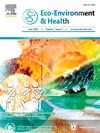Prenatal ozone exposure is associated with children overweight and obesity: Evidence from the Shanghai Maternal–Child Pairs Cohort
引用次数: 0
Abstract
Prenatal ozone (O3) exposure may disrupt normal offspring growth. However, epidemiological evidence that prenatal O3 exposure affects the physical development of offspring early in life is far from adequate. A total of 4909 maternal–child pairs from the Shanghai Maternal–Child Pairs Cohort were included. A high-resolution random forest model was utilized to evaluate prenatal exposure levels of O3 based on the home addresses of pregnant women. Group-based trajectory and mixed-effects models were used to assess associations between prenatal O3 exposure and physical parameters. Each 10 μg/m³ increase in O3 concentration was associated with 0.084, 0.048, and 0.082-unit increases in body mass index (BMI) for age Z score (BAZ), weight for age Z score (WAZ), and weight for length Z score (WLZ), respectively. Specifically, a 10 μg/m³ increase in O3 concentration was linked to a 1.208-fold and 1.209-fold increase in the elevated-increasing group for the BAZ and WLZ trajectories, respectively. Moreover, each 10 μg/m³ increases in prenatal O3 was associated with a 1.396-fold and 0.786-fold increase in the risk of BAZ- and length for age Z score (LAZ)-accelerated growth, respectively. Furthermore, a 10 μg/m³ increase in prenatal O3 was linked to a 1.355-fold increase in the risk of overweight and obesity (OAO). Our study revealed that prenatal O3 exposure is associated with accelerated BMI gain or decelerated body length gain in the early life of children. Prenatal O3 may also increase the risk of OAO in children for the first two years.
产前臭氧暴露与儿童超重和肥胖有关:来自上海母婴配对队列的证据
产前接触臭氧(O3)可能会破坏后代的正常发育。然而,产前接触臭氧会影响后代早期身体发育的流行病学证据还远远不够。本研究共纳入了 4909 对来自上海母子配对队列的母子。根据孕妇的家庭住址,利用高分辨率随机森林模型来评估产前的臭氧暴露水平。采用基于群体的轨迹和混合效应模型来评估产前臭氧暴露与身体参数之间的关联。臭氧浓度每增加 10 微克/立方米,体重指数(BMI)年龄 Z 值(BAZ)、体重年龄 Z 值(WAZ)和体重身长 Z 值(WLZ)分别增加 0.084、0.048 和 0.082 个单位。具体而言,在 BAZ 和 WLZ 轨迹中,O3 浓度每增加 10 μg/m³ 与升高增加组的联系分别为 1.208 倍和 1.209 倍。此外,产前臭氧浓度每增加 10 μg/m³ 与 BAZ 和年龄 Z 评分(LAZ)加速生长的风险分别增加 1.396 倍和 0.786 倍有关。此外,产前 O3 每增加 10 μg/m³ ,超重和肥胖(OAO)的风险就会增加 1.355 倍。我们的研究表明,产前接触臭氧与儿童早期体重指数加速增长或体长减速增长有关。产前接触臭氧还可能会增加儿童在头两年出现 OAO 的风险。
本文章由计算机程序翻译,如有差异,请以英文原文为准。
求助全文
约1分钟内获得全文
求助全文
来源期刊

Eco-Environment & Health
环境科学与生态学-生态、环境与健康
CiteScore
11.00
自引率
0.00%
发文量
18
审稿时长
22 days
期刊介绍:
Eco-Environment & Health (EEH) is an international and multidisciplinary peer-reviewed journal designed for publications on the frontiers of the ecology, environment and health as well as their related disciplines. EEH focuses on the concept of “One Health” to promote green and sustainable development, dealing with the interactions among ecology, environment and health, and the underlying mechanisms and interventions. Our mission is to be one of the most important flagship journals in the field of environmental health.
Scopes
EEH covers a variety of research areas, including but not limited to ecology and biodiversity conservation, environmental behaviors and bioprocesses of emerging contaminants, human exposure and health effects, and evaluation, management and regulation of environmental risks. The key topics of EEH include:
1) Ecology and Biodiversity Conservation
Biodiversity
Ecological restoration
Ecological safety
Protected area
2) Environmental and Biological Fate of Emerging Contaminants
Environmental behaviors
Environmental processes
Environmental microbiology
3) Human Exposure and Health Effects
Environmental toxicology
Environmental epidemiology
Environmental health risk
Food safety
4) Evaluation, Management and Regulation of Environmental Risks
Chemical safety
Environmental policy
Health policy
Health economics
Environmental remediation
 求助内容:
求助内容: 应助结果提醒方式:
应助结果提醒方式:


